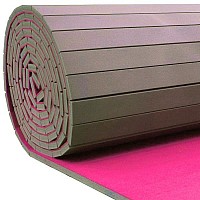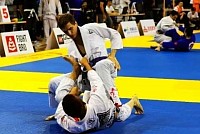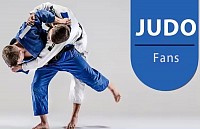Our Blog
What are the special factors that affect cheerleading mats when they are used outdoors and how to deal with them?
Weather Conditions
1. Sunlight - Impact: Prolonged exposure to sunlight can cause the material of the cheerleading mat to fade and age. The UV rays in sunlight can break down the chemical bonds in the mat's material, making it brittle and reducing its elasticity and durability.
Countermeasures: When not in use, it's advisable to store the mat in a shaded area or use a cover to protect it from direct sunlight. Some advanced cheerleading mats are now treated with UV - resistant coatings, which can also effectively reduce the damage caused by sunlight.
2. Rain and Moisture- Impact: Rain can make the cheerleading mat wet. Moisture can seep into the mat, leading to problems such as mold growth, a decrease in friction (increasing the risk of slipping), and damage to the internal structure of the mat if it gets soaked for a long time.
Countermeasures: If the mat gets wet, it should be dried as soon as possible. Use towels to absorb the surface water first and then let it air - dry in a well - ventilated place. For mats that are frequently used outdoors in wet conditions, choosing a mat with good waterproof and moisture - proof properties, such as those made of materials with a waterproof layer or hydrophobic coating, is a better option.
3. Wind- Impact: Strong winds can move or even blow away the cheerleading mat, especially if it's lightweight or not properly secured. This can disrupt the training or performance and may also cause damage to the mat if it's dragged across a rough surface.
Countermeasures: The mat can be fixed to the ground using stakes or weights. Some mats come with built - in grommets or attachment points that allow them to be securely fastened to the ground. Additionally, choosing a mat with a heavier base material or a non - slip bottom design can also help it stay in place during windy conditions.
Ground Conditions
1. Rough and Uneven Ground- Impact: An uneven ground can cause the cheerleading mat to be placed unstably. It may lead to wrinkles or bumps on the mat, increasing the risk of athletes tripping or falling during practice or performance. - **Countermeasures**: Before laying the mat, carefully inspect and level the ground as much as possible. You can use sand or gravel to fill in small depressions and remove any sharp objects or debris. Some mats are designed with a thicker and more flexible material that can better conform to a slightly uneven ground surface.
2. Grass and Dirt - Impact: Grass and dirt can stick to the cheerleading mat, making it dirty and affecting its performance. Grass stains can be difficult to clean, and dirt can reduce the mat's friction and hygiene.
Countermeasures: Place a tarp or a base layer under the mat to prevent direct contact with the grass and dirt. After use, clean the mat thoroughly to remove any grass or dirt particles. Using a mat with a surface that is easy to clean, such as a smooth - textured or wipe - clean material, can also help maintain its cleanliness and performance.
How portable are cheerleading mats? Are there design styles that are easy to carry and store?
1. Portability of Cheerleading Mats - The portability of cheerleading mats varies depending on their size, thickness, and material. Larger and thicker mats are generally less portable as they are bulky and heavy. For example, a standard - sized 16 - meter - by - 16 - meter competition cheerleading mat can be quite cumbersome to move around. However, smaller - sized mats used for personal or small - group training are relatively more portable. Mats made of lightweight materials such as certain types of foam (like XPE) are also easier to carry compared to those with a heavy rubber base.
2. Designs for Easy Carrying and Storage - Foldable Design - Some cheerleading mats come with a foldable design. They usually have creases or folding lines that allow the mat to be folded into a more compact shape. For instance, a mat might be able to be folded in half several times, reducing its overall size for easy storage in a closet or transportation in a vehicle. These foldable mats are convenient for teams that need to travel to different venues for competitions or performances.
Roll - up Design - is another popular option. Mats with this design can be rolled up like a carpet. They are often made of flexible materials that can withstand being rolled without getting damaged. A rolled - up mat takes up less space than a flat - laid one and can be easily carried using handles or straps that are sometimes attached to the mat. This design is beneficial for both storage in a gym's equipment room and transportation to outdoor events.
Interlocking and Detachable Design- There are also cheerleading mats that have an interlocking and detachable design. These mats can be separated into smaller pieces, which are easier to handle and transport. The pieces can then be quickly reassembled and locked together to form a complete mat when needed. This type of design is practical for users who have limited storage space and need to move the mats frequently.
What is the thickness of Judo Tatami Mats?
The thickness of Judo Tatami Mats can vary, but they are typically around 40mm to 50mm (1.5 to 2 inches) thick. This thickness provides enough cushioning and shock absorption to protect judo practitioners during throws and falls. However, it's important to note that the specific thickness may vary depending on the manufacturer or the specific requirements of the facility. It's always a good idea to check with the manufacturer or supplier to ensure you are getting the appropriate thickness for your needs.
What are the standard sizes for Judo Tatami Mats?
The standard size for Judo Tatami Mats is typically 1 meter by 2 meters (3.3 feet by 6.6 feet). However, there can be slight variations in size depending on the manufacturer or specific requirements of the facility. It's important to note that the International Judo Federation (IJF) has specific regulations regarding the size and quality of Tatami Mats used in official competitions. These regulations ensure consistency and safety for judo practitioners worldwide.Judo Tatami Mats are specially designed mats used in the sport of judo. These mats are made to provide a safe and cushioned surface for judo practitioners to train and compete on. Judo Tatami Mats are typically made from high-density foam or a combination of foam and vinyl, which helps absorb impact and reduce the risk of injury during throws and falls. They are also designed to be non-slip and provide good traction for footwork. Judo Tatami Mats are usually square-shaped and come in standard sizes to fit the dimensions of a judo competition area.




